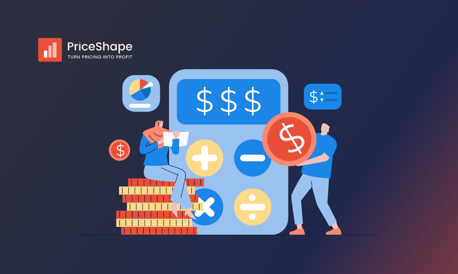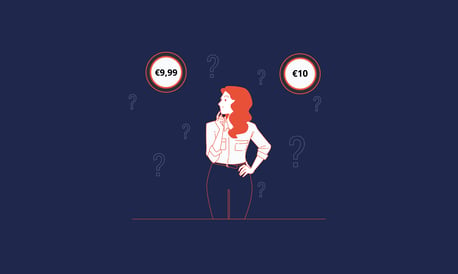How psychological pricing make people desire your products
Is it possible to affect the purchasing behavior among consumers by applying psychological pricing strategies? You can find out by reading this blog post.
A study from Namogoo 2018 examined the online purchasing behavior of 1,300 online consumers. The result indicates that 90% of the consumers describe prices and shipping fees as the most important criteria for online shopping. 55% of the consumers have answered that they are willing to click on another retailer's site that offers the product they are looking for at a lower price. The consequence is that you risk losing market shares if your prices are not competitive. In addition, 80% of online consumers who buy from another site are likely to buy from this site again.
The irrational consumer
The purchasing behavior on the market is affected by irrationality among the consumers. A current example, which we are all familiar with, is related to the purchasing behavior during covid-19. Consumers acted irrationally. They were buying huge amounts of ordinary goods such as water, toilet paper, and yeast. All this happened, even though it was unnecessary, as none of the goods were sold out. Therefore, your business must be able to adapt to the changing behaviors in the market.
What is psychological pricing?
Psychological pricing is a strategy applied to capture the attention of the consumers. The purpose is to make the products more desirable. This pricing strategy requires an understanding of your own brand. You have to ensure that the decided price is associated with the true value related to your product/service. The following box provides an overview of the different factors you must consider if you apply psychological pricing.
Factors you must consider to apply psychological pricing most effectively:
- Who sells the product/service:
You must consider whether your brand is associated with a luxury brand or an ordinary brand? The value of your brand is related to the price you can charge for your product. If you sell a luxury brand, you can charge a higher price than the case when selling an ordinary brand.
- The context where the product/service is presented:
The context where you are presenting your product influences the price the customers are willing to pay. If you are presenting your product in an exclusive context, such as a luxury hotel, then you can allow yourself to charge a higher price.
- Consider the degree of uniqueness which your product/service represents:
This also influences the price you can charge. If your product is associated with a unique value, then you can charge a higher price. The reason is that the customers are willing to pay more for a unique product.
- How is the price of the product/service communicated:
The way you present and communicate your price influences the perception of your product. It is essential to use positive words in the product descriptions. This increases the willingness to buy your product.
Example of framing
Your company can apply framing as a psychological strategy. This approach affects the decision-making process of the consumers. Framing is about the way you present your product.
In the following part an example of framing is presented. The focus is on an ordinary chocolate bar.
· We are adding a geographic area to the product: A Canadian chocolate bar.
· In this part we are adding an extra element to the product: A Canadian mint chocolate bar.
· Lastly, quality and nostalgia are connected to the presentation of the product: An exclusive Canadian mint chocolate bar.
The above example demonstrates how important it is that you present your products most desirably. Moreover, it is relevant to make a detailed and exciting product description. You can apply framing as a psychological tool to attract more customers.
Example of ‘the paradox of choice’
Barry Schwartz, who is a professor in psychology, has studied the phenomena ‘the paradox of choice’. He describes it in the following way:

Concerning ‘the paradox of choice,’ the modern consumer is exposed to many different products daily. Especially the development of online shopping has increased this tendency.
To ensure the most satisfied customers, you have to separate your products from identical items in the market. This is necessary, as you otherwise risk losing market shares. Your customers will not be able to make a final decision if they are exposed to too many identical goods. An option is to separate your products based on price.

One of the largest and most influential webshops focuses on managing the challenges behind ‘the paradox of choice.’ This is seen in the picture above, where four almost identical shoes are differentiated based on price. By presenting the products in this way, the webshop can nudge the customers to make a final choice. This happens even though the consumers are faced with a great number of different options.
Example of how consumers get affected by own biases
A Ted Talk presented by Maciej Kraus considers how consumers are affected by their own biases when making a purchase. The example focuses on a coffee shop selling two sizes of coffee cups.
· Small coffee cup: $4
· Large coffee cup: $8
In this case, 87% of the consumers decide to buy a small coffee cup. However, if a medium-size coffee cup is introduced, this affects consumer behavior.
· Medium coffee cup: $7
After introducing the medium-sized coffee cup, 74% of the consumers decide to buy the large coffee cup at 8 $. The reason is that the purchasing behavior of the consumers is affected by their own psychological biases.
The best deal seems to be when the customers are buying the large coffee cup instead of the medium size. This is because the price difference is only at 1 $ and thereby seems almost nonexistent.
The above example demonstrates that your company can beneficially take advantage of psychological biases.
The use of odd-even pricing
Odd-even pricing builds on the power of numbers and how these drive consumers to make a purchase. A study has shown that 90% of 840 examined advertising prices ended on the numbers 9 or 5. This indicates that often odd pricing is applied to attract the attention of the consumers.
Odd-even pricing can be applied in different ways. An example is related to making a discount.
· A price of $10 is discounted to $8,99.
· The price of $8.99 is perceived by the consumers as closer to $8 than to $9.
This example demonstrates that your products can be perceived cheaper than what is actually the case. It is a very beneficial strategy for your firm.
Additionally, if you are selling a luxury brand, it is worth considering applying even pricing. Even prices give a sense of “wholeness” and thereby seem more trustworthy in this case.
Overall, odd-even pricing has a great impact on the purchasing behavior among the consumers. It will be possible to control your brand if odd-even pricing is applied in the right manner.
How to apply psychological pricing most effectively?
As stated, price is the most important criterion for consumers. It is important to understand different pricing positions and pricing strategies to avoid losing market shares. This activity also makes it possible to apply dynamic pricing strategies.
To ensure the most effective outcome for your marketing position, it is crucial to research the overall market. Additionally, you have to understand the competition in the market. This includes understanding who sells the same products as you. An overview can be provided by applying different price comparison tools.
A simple way to meet the challenges in the market is by applying PriceShape Software. This tool is a market-leading service, which provides you a wide range of opportunities. One of these is the possibility of using dynamic pricing. Dynamic pricing allows your company to adjust your prices in real-time. Additionally, it is also possible to analyze the prices of your competitors. PriceShape software thereby makes it simpler for you to optimize your shopping feeds regarding where you are competitive in the market.


